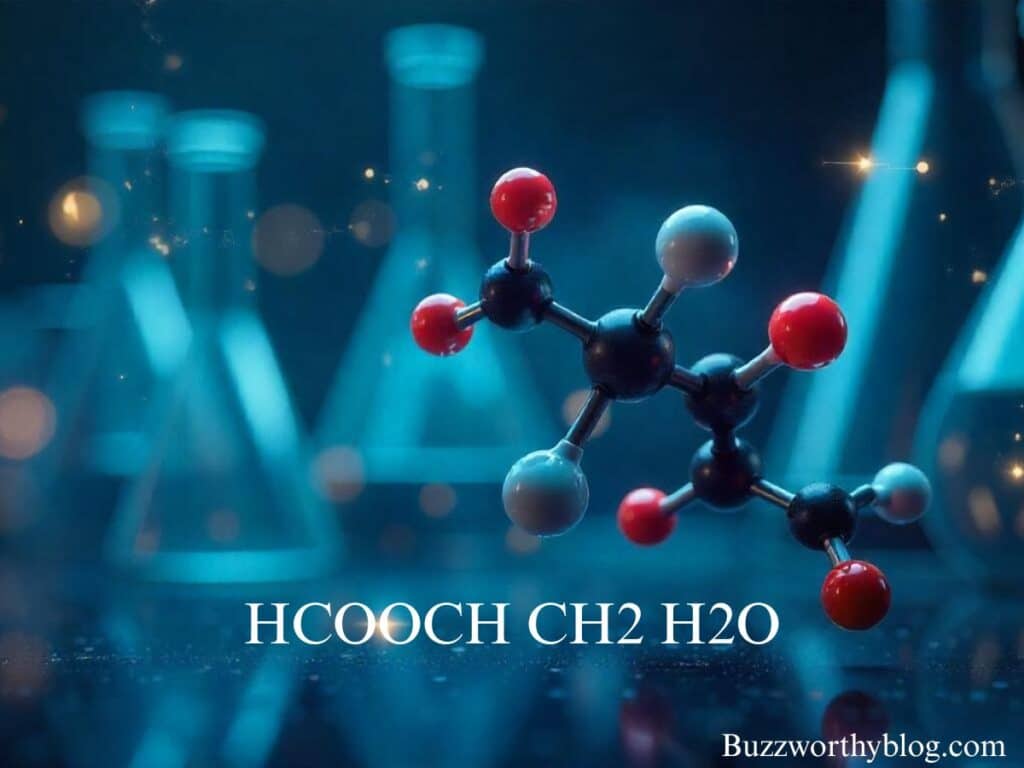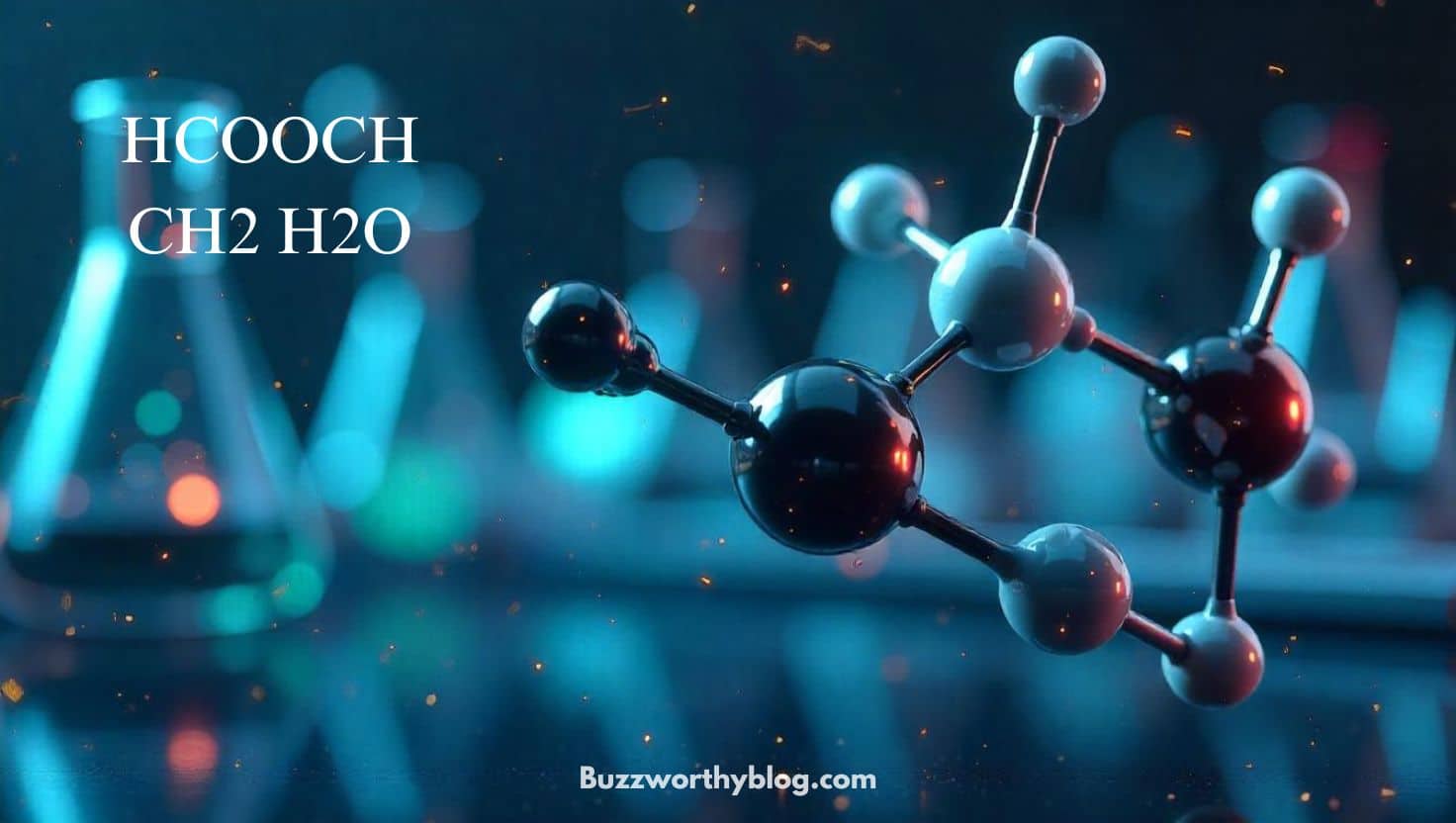I. Introduction
Have you ever stumbled upon the formula HCOOCH CH2 H2O and wondered if it points to a real chemical compound? You’re not alone. Many students, researchers, and curious minds find such formulas puzzling.
In today’s chemistry-rich world, it’s easy to get lost between authentic compounds and confusing representations. This guide dives deep into the truth behind HCOOCH CH2 H2O, explores related real-world chemicals, and clears up common misunderstandings.
Ready to sharpen your chemical instincts? Let’s dive in!
II. Understanding the Chemical Formula

At first glance, HCOOCH CH2 H2O looks complicated, but let’s break it down piece by piece:
| Fragment | Interpretation |
| HCOOCH | Possibly refers to a formate ester. |
| CH₂ | A methylene group, unstable on its own. |
| H₂O | Familiar water molecule. |
Key insights:
- HCOOCH is close to methyl formate (HCOOCH₃), an important organic ester.
- CH₂ cannot exist alone; it’s a reactive fragment needing bonds.
- H₂O (water) is a complete and stable molecule by itself.
When merged without proper structure or parentheses, this combination doesn’t form a stable or recognised chemical compound. In chemistry, structure matters: the way atoms bond defines the molecule’s identity and behaviour.
In short, HCOOCH CH2 H2O, as written, does not follow standard chemical notation.
III. Does HCOOCH CH2 H2O Exist?
Short answer: No, it does not.
In real chemistry:
- Molecules must have stable, logical bonds.
- Methyl formate (HCOOCH₃) is a real, important ester.
- CH₂ alone cannot survive; it’s too reactive.
- H₂O stays separate unless involved in a reaction.
The confusion likely stems from reactions like ester hydrolysis, where methyl formate reacts with water:
[ \text{HCOOCH}_3 + \text{H}_2\text{O} \rightarrow \text{HCOOH} + \text{CH}_3\text{OH} ]
Here, bonds are properly accounted for, and real molecules are formed.
Thus, while the pieces of HCOOCH CH₂ H₂O exist individually, the combined formula is chemically invalid.
IV. Related Compounds You Should Know
Even if HCOOCH CH2 H2O doesn’t stand, understanding its fragments connects you to key real compounds:
Methyl Formate (HCOOCH₃)
- Light, sweet-smelling liquid.
- Used as a solvent and in manufacturing foams and resins.
Formic Acid (HCOOH)
- Strong-smelling acid found naturally in ant venom.
- Used in leather tanning, textile processing, and rubber production.
Methanol (CH₃OH)
- Simple alcohol is created during ester hydrolysis.
- Important in fuel production and as a chemical feedstock.
Real Reaction Example:
| Reactants | Products |
| Methyl Formate + Water | Formic Acid + Methanol |
This reaction showcases true chemical transformations, unlike the disjointed HCOOCH CH2 H2O suggestion.
V. Applications and Importance of Related Compounds
Understanding methyl formate and formic acid is more practical than you might think!
Here’s how they influence industries worldwide:
Applications of Methyl Formate:
- Producing quick-evaporating solvents.
- Creating foams for insulation.
- Manufacturing resins for coatings.
Applications of Formic Acid:
- Preserving livestock feed (a natural antibacterial agent).
- Tanning leather and processing textiles.
- Acting as an industrial cleaner.
Their versatility stems from their simple yet powerful chemical properties.
By mastering small molecular changes, industries create products we use daily, from furniture to clothing.
Pro tip:
When learning about organic compounds, always track how a minor structural shift (like adding a water molecule) can change the entire behaviour of a substance!
VI. Common Misinterpretations Explained
Misread formulas happen more often than you think, especially in online content. Here’s why mistakes like HCOOCH CH2 H2O occur:
1. Missing Parentheses
Parentheses group atoms correctly. Without them, it’s easy to misinterpret the molecule.
2. Neglecting Bonding Rules
Atoms like CH₂ must be properly bonded to remain stable.
3. Trusting Unverified Sources
Always cross-check unfamiliar chemical names and formulas using databases like:
- PubChem
- ChemSpider
- Reaxys
Quick tip:
If a formula seems odd or incomplete, it probably is. Chemistry demands clear, logical connections!
VII.Conclusion
Although HCOOCH CH2 H2O looks like a chemical formula, it doesn’t represent a real, stable compound.
However, exploring its parts leads us to important substances like methyl formate and formic acid, both vital in industries and scientific research.
Understanding proper chemical notation prevents confusion and deepens your appreciation of chemistry’s precision.
Always verify structures and stay curious, because in chemistry, even small details matter!
FAQs
Is HCOOCH CH2 H2O a real compound?
No, HCOOCH CH₂ H₂O is not a recognised chemical compound; it combines fragments without forming a stable molecule.
What does HCOOCH represent in chemistry?
HCOOCH usually refers to a formate group and is closely related to methyl formate (HCOOCH₃), a real organic ester.
Can CH₂ exist by itself in chemistry?
No, CH₂ alone is unstable and must bond with other atoms to form a stable structure in any real compound.
What happens when methyl formate reacts with water?
Methyl formate reacts with water through ester hydrolysis to produce formic acid (HCOOH) and methanol (CH₃OH).
Why is chemical notation important?
Proper chemical notation ensures atoms are correctly bonded, preventing misinterpretations and maintaining chemical accuracy.
Guiding BuzzworthyBlog navigates the beat of the contemporary world, exploring topics that range from technology breakthroughs and commercial approaches to well-being and overall lifestyle advice. Bespoke and tailored to individual needs and desires, Buzzworthyblog writes from the heart when extracting trends, demystifying complex topics for the everyday reader who wants to be informed and empowered.

